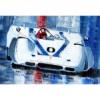Beach racing was popular in New Zealand too. One account says it began in 1912 and lists seven venues used into the late 1930s.
It appears to have been the main form of motor-racing (as distinct from hillclimbs and sprints) until dirt oval 'speedway' racing became widely popular in the mid-late 1930s. The beach races drew entries from Australia and from some New Zealand dealerships (importers).
I don't know the exact legal position, but it seems to have been near-impossible to close public roads for racing. There was apparently just one 'road race' meeting before WWII, on unsealed roads on the outskirts of Auckland in 1933.
Cars that raced on the beaches included Bugattis, Brooklands Vauxhalls, American Mercer and Miller racers, ex-TT and grand prix Sunbeams, one of the Parry Thomas Brooklands cars, a Stutz, Rileys, Austins (including the Ulster) and in the early years modified Model Ts.
Other marques in the records include Alvis, Fiat, Chrysler, Essex, Cadillac, Packard, Hudson, Buick and Wolseley, many of them modified or the basis for Kiwi specials.
Photos confirm there were plenty of outright racing cars.
Scott Thomson's 2006 book on Ron Roycroft, Up to Speed, has chapters on most of this period. An earlier book, Flat to the Boards, by Dick Messenger and Doug Wood, is said to cover pre-WWII motor racing in NZ comprehensively. Graham Vercoe's 1991 book Historic Racing Cars of New Zealand describes many of the significant machines.
Rob B














